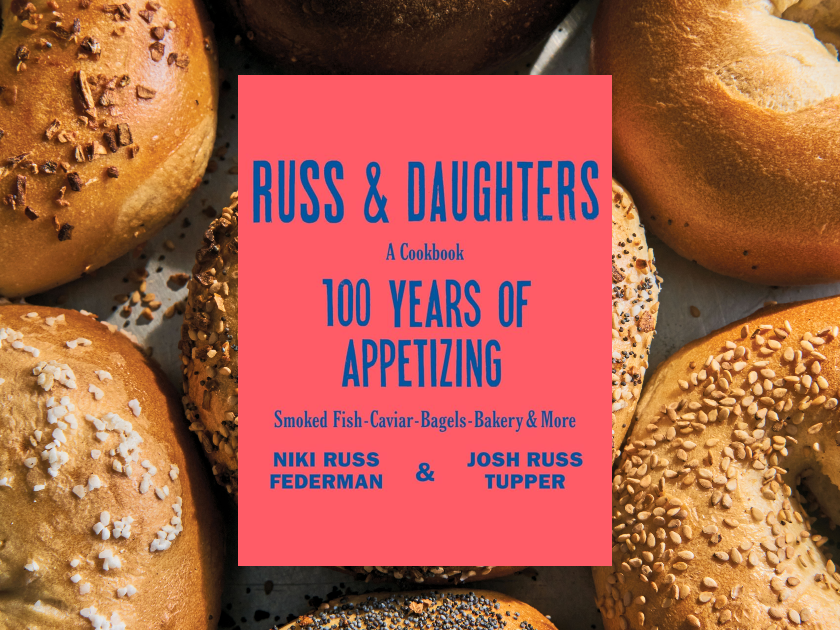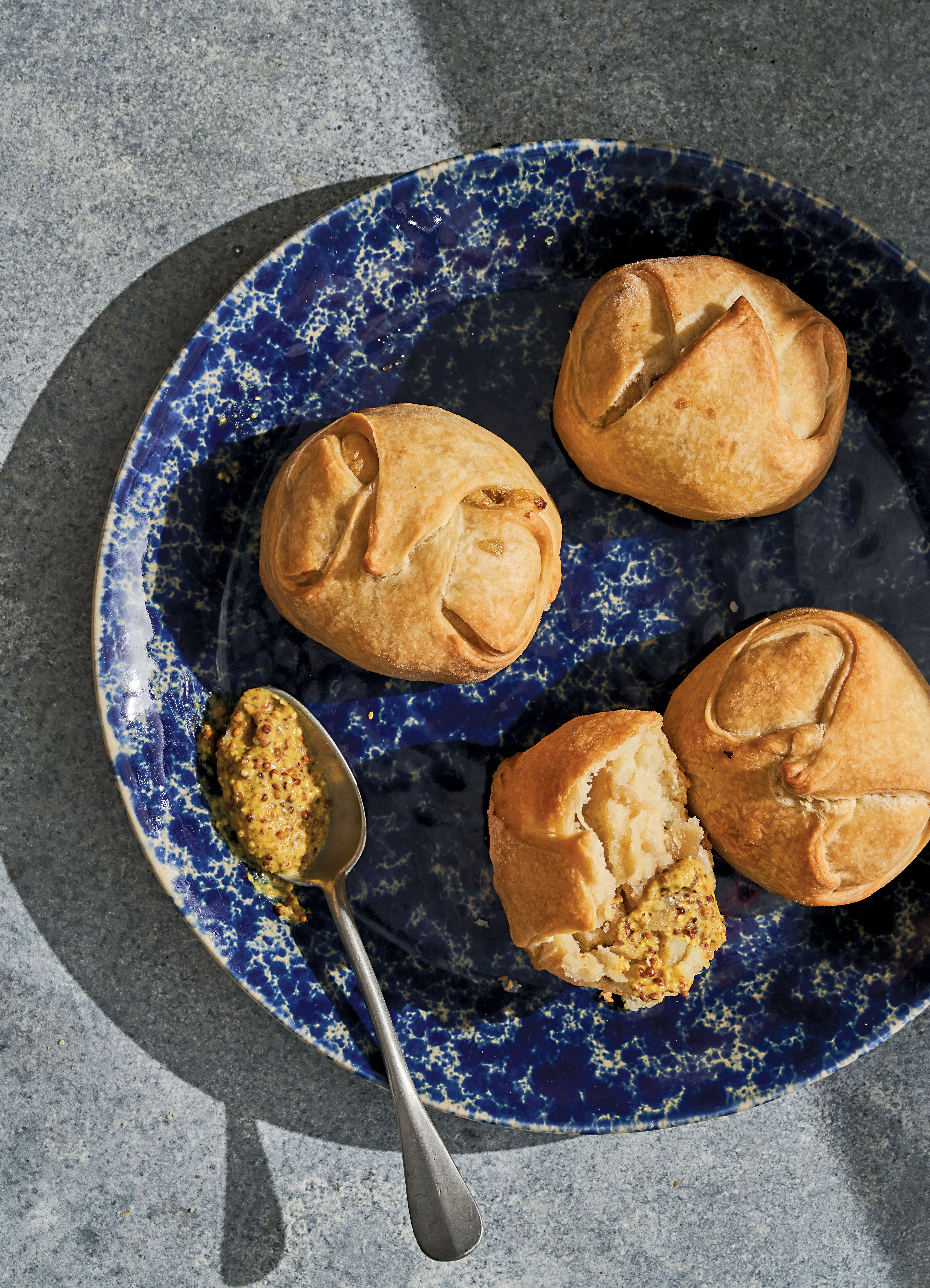
Background photo, cropped, by Gentl & Hyers excerpted from RUSS & DAUGHTERS: 100 Years of Appetizing
Potato Knishes
Once the knish was the king of the Lower East Side. A filling dish of ancient origin among poor ukrainian Jews, the knish arrived on the Lower East Side with the influx of immigrants in the late 1800s. A knish offers affordable and soul-warming sustenance in the form of mashed potatoes and onions garbed in a golden dough. Great wars were fought over the knish — or at least, modest skirmishes across Rivington Street — by opposing knish-mongers. Like the bagel — and the Jewry of the Lower East Side — eventually the knish went mainstream. Also like the bagel, many versions abounded. The street cart knish is large and leaden. The stadium knish is larger still. Our version returns the knish to its more natural proportions. These aren’t gut-busting bricks of carbs, but rather ethereal — Ok, semi-ethereal — handheld dumplings filled with an airy onion-potato mixture.
Makes 1 Dozen Knishes
For the Filling
3 medium russet potatoes (about 1½ pounds), peeled and cut into chunks
3 tablespoons vegetable oil
1 large Spanish onion, finely chopped
2 teaspoons onion powder
1 teaspoon kosher salt, plus more as needed
For the Dough
2¼ cups all-purpose flour, plus more for rolling and shaping
½ cup vegetable oil
¼ cup water, plus more as needed
1 large egg
½ teaspoon baking powder
1 teaspoon kosher salt
½ teaspoon white vinegar
Make the Filing
Bring a medium pot of water to a boil over high heat. Add the potatoes and cook, stirring occasionally, until tender, about 20 minutes. Drain through a colander, then return the potatoes to the pot and use a potato masher or sturdy fork to mash until completely smooth.
Meanwhile, heat the oil in a medium saute pan set over medium-low heat. Add the onion and cook, stirring often, until soft and golden, 15 to 20 minutes. Let cool.
Add the cooled onions to the mashed potatoes along with the onion powder and salt, and stir to combine. Taste and add more salt, if needed.
Make the Dough
Use a ¼‑cup measuring cup to form 12 portions of the mashed potato mixture and place on a large, parchment-lined baking sheet. Cover with plastic wrap and refrigerate for at least 2 hours, or up to overnight.
Combine the flour, oil, water, egg, baking powder, salt, and vinegar in the bowl of a stand mixer fitted with the dough hook. Mix on low speed, scraping down the sides of the bowl as necessary, to form a dough, 7 to 10 minutes. The dough will feel relatively oily at this stage. Cover the mixer bowl and let the dough rest for 30 minutes.
On a well-floured surface, using a floured rolling pin, roll the dough into an ⅛‑inch-thick rectangle about 12 by 16 inches.
Use a sharp knife to cut the dough into twelve 4‑inch squares. (There will be excess dough. Discard it or save it for another use.)
To Assemble and Bake
Preheat the oven to 400°F and line a large baking sheet with parchment paper.
For each knish, place one portion of the filling in the center of a square. Fold two opposite corners of the dough up and over the filling, pinching the corners together to seal (use a little water to act as a glue, if needed). Repeat with the opposite two corners to form a little parcel, and place the knish on the lined baking sheet.
Bake the knishes, rotating the baking sheet back-to-front halfway through, until golden brown, 25 to 30 minutes. Transfer the knishes to a wire rack to cool. Serve slightly warm or at room temperature.
Store leftovers, well wrapped, in the freezer for up to 6 months. Reheat briefly in an oven or toaster oven.

Excerpted RUSS & DAUGHTERS: 100 Years of Appetizing by Niki Russ Federman and Josh Russ Tupper. Copyright © 2025 by Niki Russ Federman and Josh Russ Tupper. Reprinted with permission from Flatiron Books. All rights reserved. Photography by Gentl & Hyers. Illustrations by Jason Polan, LLC.
Niki Russ Federman is the fourth-generation co-owner of Russ & Daughters. At the age of 27, Russ Federman chose to return to the shop in which she grew up. Together with her cousin, Josh, she has grown Russ & Daughters into what it is today, while preserving its cultural and culinary legacy. Russ Federman has been featured in The Sturgeon Queens, the award-winning documentary about Russ & Daughters; television shows such as Taste the Nation with Padma Lakshmi and Anthony Bourdain’s No Reservations; and publications including The New York Times, The New Yorker, Food & Wine, Zagat, Vogue, and W Magazine. She was inducted into the Manhattan Jewish Hall of Fame and has an encyclopedic entry in the Jewish Women’s Archive. She lives in Brooklyn with her husband, Christopher, and two children.
Josh Russ Tupper is the fourth-generation co-owner of Russ & Daughters. Raised in an ashram in upstate New York, Russ Tupper was working as an engineer in Portland, OR, when the opportunity arose to join his family business at 26. He has been leading Russ & Daughters with his cousin Niki ever since. He has been featured in media outlets such as NPR, Food Network, The Travel Channel, Forbes, The Cut, Kinfolk, Lucky Peach, The New Yorker, and Vogue. He is also one of the subjects of documentary The Sturgeon Queens. Called “the Babka Baron” by the New York Times, Josh has been honored by the Museum of Food and Drink for his contributions to NYC food culture. He has taught at the YIVO Center for Jewish Research and Astor Center. Russ Tupper lives with his wife, Denise, and two daughters.
Joshua David Stein is a cookbook and children’s book author, journalist and restaurant critic. His work includes Notes from a Young Black Chef and My America, with Kwame Onwuachi; Il Buco: Stories & Recipes, with Donna Lennard; The Nom Wah Cookbook, with Wilson Tang; Vino: An Essential Guide to Real Italian Wine, with Joe Campanale; Jang: The Secret to Korean Cooking, with Mingoo Kang and Nadia Cho; Why I Cook? with Tom Colicchio and many more. Among his children’s books are What’s Cooking?; Can I Eat That?; Brick: Who Found Herself in Architecture; Solitary Animals: Introverts of the Wild and The Catalogue of Hugs. He lives in Brooklyn with his sons, Augustus and Achilles.



